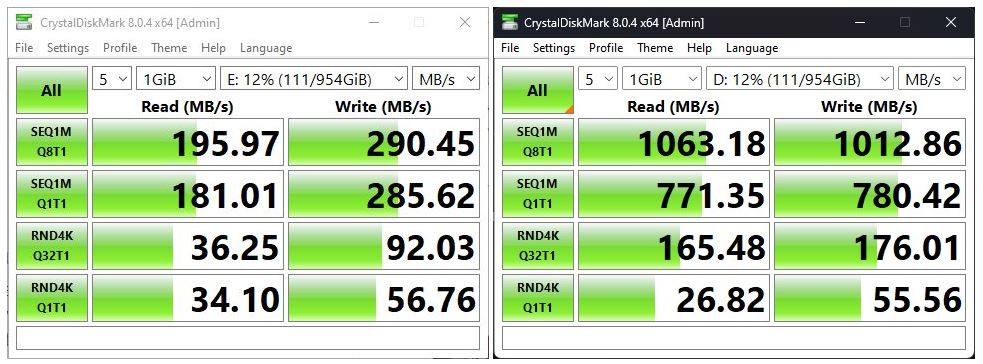I had a revelation via contrasting benchmarks yesterday. A friend returned a mid-range USB 3.1 NVMe drive enclosure after an extended loan. Thus, I popped it into my production desktop (an i7 Skylake Gen 4 PC) to see how fast it ran. Good enough. Then, just for grins I popped it into the 2021 vintage Lenovo P16 Gen 1 Mobile Workstation (an i9 Gen 12 PC). Much faster! Enough so, in fact, that it’s clear that newer USB justifies added costs of acquisition. Let me explain…
Why Say: Newer USB Justifies Added Costs?
Take a look at the lead-in graphic. It shows the difference between older USB technology in the Skylake desktop vs. newer USB technology in the Gen 12 mobile workstation. Both are using USB 3.1 ports (though the older PC goes via USB-A, the newer goes thru USB-C) to the same hardware running the same benchmark. Why is the new so much faster than the old?
Short answer: UASP, aka the USB Attached SCSI Protocol. The newer PC supports it, while the older one does not. You can see there’s a driver difference in Device Manager when it comes to accessing the NVMe drive enclosure and its installed SSD: the older machine runs a driver named USBSTOR.sys, while the newer one runs UASPStor.sys. Plain as day.
The Deal With UASP
The Wikipedia article on UASP is a good place to find some explanation. To wit: “UAS [USB Attached SCSI] generally provide faster transfers when compared to the older USB Mass Storage Bulk-only (BOT) protocol drivers.” In a nutshell, that’s UASPStor.sys versus USBSTOR.sys.
As I learned about this technology in the period from 2016 to 2019, the word at TenForums.com ran something like “Speeds of 500 MBps mean USB bulk transfer; 1 Gbps or better means UAS transfer.” And that, dear readers, is the difference you see between the right-hand side in the lead-in graphic (USBSTOR.sys on the Skylake) and the left-hand side (UASPStor.sys on the Gen 12).
In practical terms, this translates into much, much faster IO on the newer PC vis-a-vis the older one. I think it’s incredibly worthwhile, given that backups complete 2-3 times faster on the P16 than the Skylake. Likewise for big, bulk file transfers (such as Windows ISOs, which I mess with frequently).
Retrofit and Replacement
Does this mean one has to toss older PCs and replace them with newer models? Maybe, but not necessarily. For between US$50 and 100, you can purchase UASP capable PCIe adapter USB cards. As long as you’ve got an open PCIe x4 port available on your motherboard (desktops only, so sorry) this could be a good solution. I’m a fan of this US$95 StarTech unit for that purpose.
Older laptops can be dicey and depend on support for USB ExpressCards. I mucked around with these on some 2012-vintage Lenovo ThinkPads in the 2014-2016 timeframe (an X1 and a T420). They work, but they’re cumbersome and expensive (see this Amazon Review for a great discussion).
For best results, it may be time to shell out for a new desktop or laptop PC. That way, the fastest USB (and even Thunderbolt) technologies are likely to come built-in and ready to go. Could be worthwhile!
